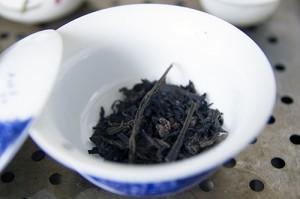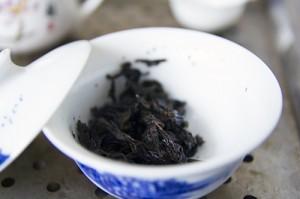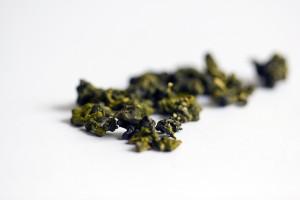Very frequently, when I am making tea for guests, I am asked why I rinse or do not rinse the tea prior to brewing.
This simple step in making tea is often contentious, with fervent advocates on both end of the argument.
But we are getting ahead of things, first things first:
What is ‘rinsing’?
Rinsing (洗茶) or blanching (温润泡) is sometimes known as the first brew. It is pouring hot water over un-used tea leaves for the first time, infusing it for a short 5 to 20 seconds and discarding the liquor.
Why do we ‘rinse’?

i) Get rid of dust, dirt and microbes build up
ii) Remove the caffeine in tea- 80% according the some
iii) Allow the leaves to expand partially and prepare it for steeping
The first one is quite straightforward, at least in terms of how it’s accomplished. We rinse vegetables for the same purpose. (More on this here)
De-caffeination?
This is one of the favorite topics of ‘myth busters’. The popular myth is that by steeping the tea for 30 seconds or so, approximately 80% of all caffeine will be removed.
Hence, this is a simplistic home decaffeination method since no fancy equipment is required.
Most articles on this topic frequently reference this article written by Nigel Melican of Teacraft who is considered one of the foremost experts on tea outside of China.
Like most of Mr. Melican’s writings, it is cogent, succinct and very confident.
One research (Hicks et al) he referenced drew this conclusion:
30 seconds: 9% caffeine removal
1 minute: 18% caffeine removal
2 minutes: 34% caffeine removal
3 minutes: 48% caffeine removal
4 minutes: 60% caffeine removal
5 minutes: 69% caffeine removal
10 minutes: 92% caffeine removal
15 minutes: 100% caffeine removal
Prima facie it would seem like the caffeine removal of ‘rinsing’ tea is a complete fallacy.
Not that I disagree completely, I merely wish to point out because the experiment (not Mr. Melican’s writings) is poorly constructed, it is not as conclusive as you would think.

In other words, this is akin to saying that because someone weighs 53 kg at age 30 and weighed 3 kg at birth, at age 20 she would weigh approximately 33 kg.
Secondly, the experiment uses a beaker to infuse the tea leaves. No mention of whether it was covered but it would be a safe assumption to say it wasn’t.
If you have tried infusing the same tea in a mug versus a gaiwan side by side, you would realize there’s a huge difference in the taste of the tea. What gives tea its taste are dissolved compounds such as amino acid, polyphenol and yes caffeine.
Hence it is a fair assumption that the dissolution of caffeine might be different if used in a gaiwan as opposed to a beaker where it was measured in the experiments conducted by Hicks et al.
Note that I am by no means suggesting that rinsing causes decaffeination but merely that it is not as conclusive as most casual readers of that article claim. Perhaps when one day we have a budget that allows us to run tests like this (hint hint)
‘Preparation’ of the Tea
Depending on the type of tea, some tea leaves can be quite tightly rolled (Minnan and Taiwanese Oolongs) and compressed (Pu-er and other dark tea cakes and bricks).
When you are brewing the tea gongfu style, a 20-30 seconds infusion may not suffice to get the leaves to unfurl much in the first infusion.
There lies the purpose of the ‘rinse’, a ‘warm-up’ brew so the leaves may be primed for the ‘proper’ infusion.
Arguments against ‘rinsing’
It is said that many of the nutrients of the tea would be lost in the ‘rinse’ since some of them are most easily dissolvable.
As such, unless required, ‘rinsing’ would be considered a ‘waste’.
So, should we ‘rinse’ or not?
Putting it all together- ignoring the inconclusiveness of point ii)- the simplest answer would be it depends on which type of tea.

For green and yellow teas- at least those produced in China and Japan- freshness is of paramount importance. The notion of green tea leaves left out in the open to accumulate dust and dirt is inconceivable. (See here for storage of green tea)
Green and yellow teas are also in general made from more tender leaves (with some notable exceptions) and hence are usually not as tightly rolled as Minnan Oolongs.
For white teas, they are un-rolled and like green and yellow teas, stored in airtight containers. Hence they don’t require rinsing for purposes i) and iii).
For black teas it is less conclusive as it depends on how tightly rolled the leaves are. Increasingly, more black teas are made of buds and good ones continue to be largely hand-rolled. Hence the need for blanching is lesser.
For oolong teas, as mentioned, Minnan and Taiwanese Oolongs are especially tightly rolled into beaded shapes. Coupled with their shorter infusion times, rinsing is recommended for oolong tea.
Rinsing is strongly recommended for dark teas, especially those that are aged and compressed.
Firstly, in the production of dark teas, microbes will cause actual fermentation (not oxidation) to occur in the leaves. The rinsing will get rid of that.
Secondly, aging dark tea requires a bit of airing. With that comes dust and dirt, unless you store it in an industrial clean room.
Third, many dark teas are tightly compressed. The rinse helps the leaves to ‘de-compress’.
In a Nutshell
In summary, our recommendation is that
Green, yellow and white teas do not need to be rinsed.
Black tea- depends on the type
Oolong tea- yes
Dark tea- yes, in fact rinse twice for aged tea stored in wetter climates.
Please click to see other articles related to brewing tea.
